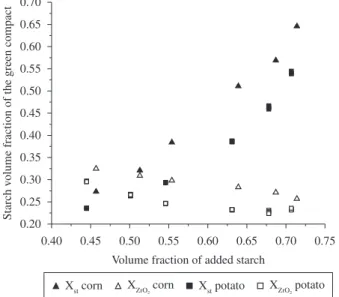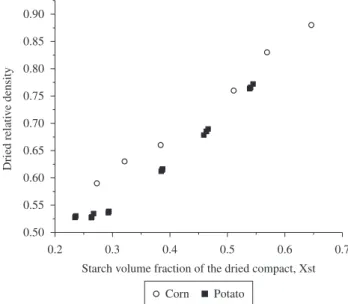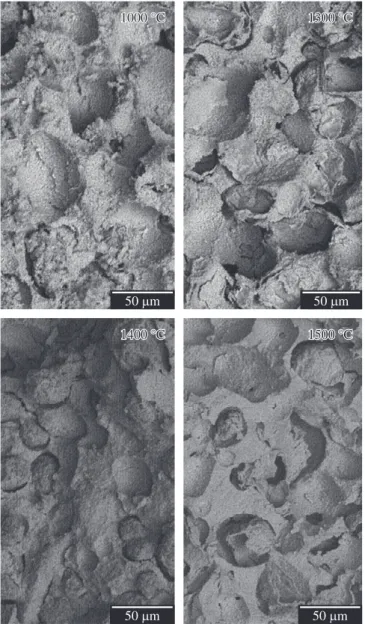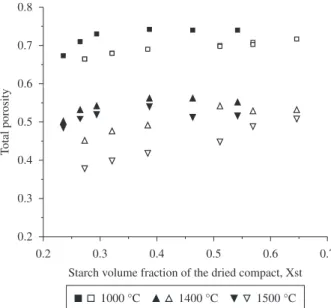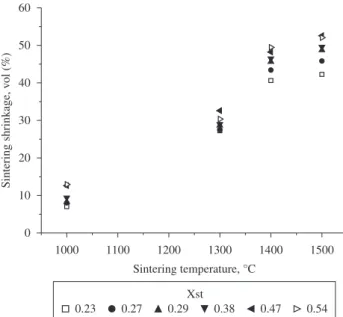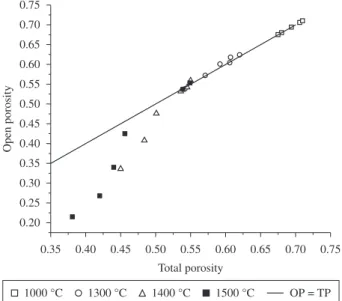*e-mail: lgarrido@cetmic.unlp.edu.ar
Influence of Starch Type on Characteristics of Porous 3Y-ZrO
2Prepared
from a Direct Consolidation Casting Method
Liliana Beatriz Garridoa*, Maria Patricia Albanob, Luis Antonio Genovac, Kevin Paul Plucknettd
a,b
Centro de Tecnología de Recursos Minerales y Cerámica – CETMIC (CIC-CONICET-UNLP),
Cno. Centenario y 506, C.C.49, B 1897 ZCA, M. B. Gonnet., Buenos Aires, Argentina
c
Instituto de Pesquisas Energéticas e Nucleares – IPEN,
Centro de Ciência e Tecnologia de Materiais – CCTM,
Cidade Universitária, Travessa R 400, CEP 05508-900, São Paulo, SP, Brazil
d
Department of Process Engineering and Applied Science, Dalhousie University, 1360, B3J 1Z1,
Barrington Street, Halifax, Nova Scotia, Canada
Received: August 6, 2010; Revised: February 18, 2011
Starch consolidation casting has been successfully used to produce porous ceramics with complex shapes at a relatively low producing cost. In this work, porous 3Y-ZrO2 ceramics were produced using two types of starch (corn and potato). Concentrated (50-52 vol. (%)) aqueous suspensions of the different 3Y-ZrO2-starch mixtures (i.e. starch to zirconia weight ratios between 0.20 and 0.52) were thermally consolidated and the effect of the type and amount of added starch on properties of resultant dried product was examined. After starch granules burnout, the effect of sintering temperature varying between 1000 and 1500 °C on the porosity evolution, interconnection and morphology of pores and microstructure of final ceramic was followed by water absorption measurements, Hg porosimetry and scanning electron microscopy SEM. Typical microstructure of the ceramic sintered at 1500 °C consisted of large nearly spherical pores (created by starch) uniformly distributed in a dense ZrO2 matrix. As the content of starch in the dried product (expressed as volume fraction) Xst is increased from 0.23 to 0.65, porosity of the ceramic sintered at 1500 °C increased from 38 to 52 vol. (%) for corn starch, while it achieved 50 to 54 vol. (%) for potato starch; thus, lower Xst of potato starch developed a porous zirconia with higher porosity. In this case, the pore structure contained pores having sizes above 50 µm and resulted completely interconnected while for those prepared using corn starch the pore interconnection occurred for Xst above 0.50.
Keywords: porous ceramics, zirconia, starch consolidation casting, starch types
1. Introduction
Starch consolidation casting is a suitable method to prepare many porous ceramics including alumina1,2, calcium carbonate3,
cordierite4, mullite5, electroceramics6, silicon nitride7 and recently,
zirconia (ZrO2)8. Among other applications, products like filters,
catalyst supports and bioceramic materials were successfully processed using the starch consolidation casting. For this process, finely sized ceramic powders and commercially available types of starch (i.e. coming from different origins: cereal, root, tuber, etc.) can be used9-12. Starch has two functions in this process; primary is added
to the ceramic composition as a fugitive additive. Pores are formed after burnout of granules by heating. Also, starch forms a gel during consolidation which provide green strength through formation of bonds with ceramic acting as a binder for the particles9.
The advantages of this process are the high homogeneity of the ceramics, the preparation of complex shaped bodies in combination with the low producing cost and the ready availability of the pore forming agent.
The starch consolidation casting method involves the following stages: the preparation of a concentrated ceramic suspension with the addition of starch, the consolidation of the suspension in a non porous mold at 60-90 °C, the burn out of the organics and finally sintering. Previous studies revealed that by adjusting the thermal treatment significant variation in pore structure such as pore volume fraction, shape and size of resulting pores, can be achieved10-14.
Some of these stages are common with conventional dry processing methods which use fugitive inclusions as pore forming agents. However, the starch consolidation casting technique includes a heating step of the starch granules in water within the temperature range of 60-90 °C. The starch granules adsorb water and irreversibly swell to several times their initial size15. Then, the swollen granules
will begin to rupture and collapse. Thus, a viscous dispersion of granule fragments and dissolved molecules may finally become a viscous starch solution which can act as a binder.
The gelatinization or melting of the starch granule structure in the presence of water has been widely studied using differential scanning calorimetry (DSC)16. At high water contents, the amorphous regions
of the granules absorb water and swell. The stripping or separation of the starch chains from the crystallites result in a cooperative melting and yield a single DSC endotherm. At low water contents, however, there is not enough water for cooperative melting. This is evidenced as a second endotherm (or a ‘‘shoulder”, depending on the water content), which represents the crystallite melting after the cooperative process, at a higher temperature16. The DSC curves of the starch in
the presence of ceramic powders indicate that the temperature of gelatinization of starch is higher as the ratio of starch to ceramic decreases (probably with less available water content).
The gelatinization temperature and the heat of gelatinization (∆Hgel) depend on the starch source. Corn and rice starches generally
show higher transition temperatures than wheat and potato starches; however, the ∆Hgel values are higher for potato and wheat starches17.
The variation in gelatinization and swelling properties of the different starches are partially controlled by the amylose to amylopectin ratio, the size and shape of the granules, the phosphate ester groups on amylopectin molecule, the presence/absence of lipids and the content of dissolved substances in water. Potato starch exhibits higher swelling power and viscosity than other starches17. The varieties of
starch also exhibit differences in the morphological characteristics of the granules, such as the shape and size10,15-17.
In this work, properties of porous ZrO2 ceramics developed by starch consolidation casting method using corn and potato starches and different starch to zirconia weight ratios varying between 0.20 and 0.52 were determined. The infl uence of the type and amount of starch fi ller as well as the sintering temperature on the microstructure evolution of sintered bodies were examined. The total porosity and resultant pore structure of the sintered product were discussed in terms of the morphological properties of the individual granules.
2. Experimental
2.1. Materials and methods
Fine commercial zirconia (3Y-ZrO2) powder stabilized with 5.1 wt. (%) Y2O3 in tetragonal phase (YZ01, Saint-Gobain, France) was used in this study. The mean particle diameter and the specifi c surface area were 0.6 µm and 7 m2.g–1, respectively. Corn and
potato starches, commercially available in Argentina, were used as pore forming agent and binder. The granule size distribution was determined using a CILAS instrument (Compagnie Industrielle des Lasers, model 1064).
Different ZrO2-starch compositions with volume fractions of starch (relative to the volume of solids) in a range of 0.45-0.71 were prepared. Stabilized 50-52 vol. (%) aqueous suspensions were obtained using 0.3 wt. (%) of dispersant (Dolapix, Zschimmers and Schwartz) at pH 9. The adequate concentration of the dispersant (0.3 wt. (%)) to obtain a high ZrO2 packing density in the green body has been determined by our group in a previous study10.
The consolidation of the suspension was performed in a plastic mold, which was coated with a release agent, at 90 °C for 30 minutes. The cylindrical samples, with approximate dimensions of 25 mm diameter and 15-20 mm thickness, were dried at room temperature and then slowly at 100 °C until there was no further change in mass. The burning out of starch was achieved by slow heating up to 1000 °C with three isothermal hold steps at 150, 250 and 350 °C; the samples were then held for 2 hours at 1000 °C. Finally, the precalcined cylinders were sintered at 1300, 1400 or 1500 °C for 2 hours, using a heating rate of 5 °C/min.
2.2. Characterization of green and sintered products
The density of green compacts was measured by Hg immersion. The relative density (RD) and open porosity of sintered product were determined by the water absorption method. Density values of 6.05 and 1.45 g.cm–3 were used for ZrO
2 and starch, respectively. The
mean channel size and the pore size distribution which characterizes the channels between the large pores created by the starch granules, were determined for sintered compacts using Hg porosimetry (Carlo Erba Porosimeter 2000, Italy). The microstructure of the sintered samples was observed on fracture surfaces using a fi eld emission scanning electron microscope (FE-SEM) (Model S-4700, Hitachi High Technologies Corporation, Japan). The fracture surfaces of sintered samples were also examined with a scanning electron microscope SEM (Jeol JSM 6360 LV, Japan).
3. Results and Discussion
3.1. Description of corn and potato starches used
Figures 1a and b show the SEM micrographs of the corn and potato starch granules, respectively. Corn granules were nearly spherical or pentagonal, while those of potato were oval and had more irregular shape. The corn type had a mean granule diameter of approximately 14 µm. Potato starch exhibited larger granules with a mean diameter of 50-60 µm and a small proportion of a fi ner fraction. Thus, the potato size distribution was bimodal and composed by a major fraction with a most frequent granule size of 54 µm and a minor one (less than 10 vol. (%)) with a mean diameter of 10 µm. Corn granules also had less smooth surfaces than those of the potato type. These morphological characteristics of granules corresponded well with those previously reported for the starch varieties10,15,17.
3.2. Effect of starch type on properties of 3Y-ZrO
2dried compacts
In this study, the amount of added starch in the different powder compositions is expressed as the volume fraction of starch relative to the total solid volume. The starch content of the dried sample Xst indicates the volume fraction of starch relative to the volume of the
Figure 1. SEM micrographs of starch granules used: a) corn; and b) potato.
Figure 3. Relative green density vs. volume fraction of starch in the dried compact (Xst) for corn and potato starches.
green compact (i.e. the sum of solid and pore volumes). Thus, Xst depends on the packing density of starch and ceramic particles in the dried compact. Figure 2 shows the effect of starch type on the variation of the content of starch in the dried compact Xst with the amount of added starch in the composition; in addition, the volume fraction of ZrO2 in the green body is indicated in this fi gure. As the amount of added starch is increased from 0.45 to 0.71, Xst increased from 0.27 to 0.64 for the corn starch and 0.23 to 0.54 for the potato starch. These results showed that Xst was lower than the volume fraction of added starch thereby indicating the existence of some porosity in the dried compact. Also, Xst for compacts prepared using corn starch reached a higher value than that of identical composition of potato starch. This indicated a comparatively higher volume of the dried compact produced from potato starch. This result was corroborated by measurements of drying shrinkage of these samples. Consequently, an increase in porosity of the dried product occurred using potato starch. The variation of the relative density of the green compacts with the different content of starch Xst for the two starches used is shown in Figure 3. As the Xst is increased to the maximum value, the relative density of the green bodies increased from 0.52 to 0.77 and 0.59 to 0.87 for potato and corn starches, respectively. As the starch content increased, more dissolved starch was deposited after drying between and around the ZrO2 particles, forming a network which reduced the porosity of the dried body, thereby increasing the relative green density. The slightly higher relative density of product obtained using corn type indicated a comparatively lower porosity, in good agreement with data presented in Figure 2.
Moreover, Figure 2 shows that the volume fraction of ZrO2 in the green body XZrO2 slightly decreased from 0.32 to 0.25 and 0.27 to 0.22 with increasing starch addition for corn and potato types, respectively. At low starch content, a high amount of ZrO2 was distributed in a relatively high green volume. As the amount of starch increased, less ZrO2 was packed in a low green volume; thus, the decrease in the ZrO2 content was accompanied by a decrease in the volume of the green compact resulting in a minor variation of the ZrO2 packing density.
3.3. Microstructure of sintered porous materials
The microstructures of porous materials sintered at different temperatures are shown in Figures 4 and 5 for corn and potato starches, respectively. Two types of pores were uniformly distributed in the ZrO2 grain matrix: the spherical large pores created by starch granules and smaller voids-like channels between the ZrO2 particles. Circumferential cracks surrounding the pores appeared due to the formation of ZrO2 shells separated from the rest of the matrix. These shells were earlier observed by Lyckfeldt and Ferreira1 using
this starch processing method. The rounded pores arising from the corn starch had diameters between 7 and 10 µm whereas the pore derived from the potato starch had lengths up to 50 µm. In both cases, the pore sizes were signifi cantly larger than the interstitial voids between the ZrO2 particles, and consequently they remained stable after sintering1-8,11.
Densification of the ZrO2 matrix depended on the sintering temperature. Sintering of ZrO2 particles at 1300 °C was evidenced by the development of necks between the ZrO2 grains. Figure 6 shows higher densifi cation of the ZrO2 matrix at 1400 °C. The ZrO2 particles changed their shape by rounding off sharp corners, the necks between the ZrO2 grains grow and low porosity remained at the grain boundaries. At 1500 °C the matrix was essentially fully densifi ed. As showed in Figures 4 and 5, the majority of the circumferential cracks appeared slightly wider and quite separated from the matrix. This relative increase in size may be explained by a “desintering“ phenomena involving the circumferential shells5,8. As the starch content and sintering temperature
increased, the size of the spherical pores slightly reduced.
3.4. Effect of the content and type of starch on the
characteristics of sintered products
Figure 7 shows the total porosity of ZrO2 ceramics as a function of the content of corn and potato starches for different sintering temperatures. For a given temperature, the increase in the porosity with Xst was dependent on the type of starch used. For the potato starch, the porosity increased up to Xst = 0.4 and then with further increase in Xst porosity remained nearly constant; while, for the corn type, the porosity linearly increased with increasing starch content.
At 1000 °C, the initial stage of sintering, only limited densifi cation of the ZrO2 matrix had occurred. Consequently, the total porosity corresponded to the sum of Xst and the porosity the dried compact. The contribution of the matrix porosity became less important as Xst increased, since the relative density of the dried bodies gradually increased with increasing Xst (Figure 3). The total porosity reduced with increasing the sintering temperature to 1400 °C, mainly due to the densifi cation of the ZrO2 matrix. For identical content of starch, the porosity produced from potato samples resulted higher than that of corn ones for all the sintering temperatures.
At 1500 °C, when nearly full densifi cation of the matrix was achieved, the porosity increased with increasing Xst from 0.50 to 0.54 and 0.38 to 0.52 for potato and corn starches, respectively. Therefore, the remaining porosity at 1500 °C did not correspond to the predicted porosity based on the content of starch in the dried body. For Xst bellow 0.5, the total porosity was above the expected amount. In contrast, above this level, the porosity was lower than that predicted. At low Xst values, larger deviations from the predicted porosity were found for the potato starch. While, at high Xst samples reached a constant value of porosity which corresponded more with the predicted from starch content in the green body.
For low Xst values, the increase in the starch particle volume arising from swelling produced an increase in the size of larger pores, thereby increasing the volume percentage of porosity in the sintered body. The high content of phosphate ester groups of the potato starch molecules may contribute to a rapid swelling and the potato starch exhibits a signifi cantly larger swelling capacity than the corn starch17.
Therefore, a larger increase in the size of pores and consequently in the porosity of the sintered bodies for potato starch could be expected. For high amounts of added starch, a high percentage of the small pores created by the dissolved starch were eliminated at high sintering temperatures, resulting in a lower porosity than that predicted. This behavior was more evidence for the corn starch, suggesting a greater rupture and dissolution of this type of starch.
Gregorova et al.9 reported that the porosity formation with starch
consolidation casting is different from that of porous materials prepared without gelling the starch, i.e. with starch only acting as pore forming agent. In the last case, the total porosity of the sintered compacts followed that predicted based on the volume fraction of pore former in the green compact18-19.
Figure 8 shows the volumetric sintering shrinkage of the compacts as a function of Xst for different sintering temperatures. The sintering shrinkage exhibited a small dependence on the starch content for all the temperatures. This could be expected since the sintering shrinkage was dependent on the volume fraction of ZrO2 in the green body (XZrO2) which slightly reduced for the different Xst values (Figure 2). For each Xst value, the increase in shrinkage with increasing sintering temperature could be attributed to the sintering of the ZrO2 particles. As the XZrO2 values of the samples with potato were lower than those with corn starch (Figure 2), the volumetric sintering shrinkage was signifi cantly higher for 1000 and 1400 °C. Thus, a less effective ZrO2 packing in the matrix produced a high sintering shrinkage. However, when the ZrO2 matrix achieved full densifi cation, some
Figure 5. SEM micrographs of fracture surfaces of products prepared with the minimum potato starch content (Xst = 0.23) after sintering at different
temperatures. (Bar = 50 µm).
differences in the shrinkage behavior were found for the two starch types. At 1500 °C the shrinkage of products prepared from potato starch remained near to 50 vol. (%) similar to that at 1400 °C; whereas the increase in shrinkage with increasing sintering temperature from 1400 to 1500 °C was more than 10 vol. (%) for the corn type. The sintering shrinkage was controlled by the sintering temperature and the starch type.
3.5. Effect of sintering temperature on porous materials
prepared using corn and potato starches
Figures 9 and 10 demonstrate the evolution of the total porosity and shrinkage with the sintering temperature, respectively, for corn starch. The effect of potato starch on these characteristics is shown in Figures 11 and 12. The reduction in porosity with increasing the
Figure 7. Total porosity of samples sintered at different temperatures as a function of the starch content in the dried compact for corn (open symbols) and potato (filled symbols) starches.
Figure 8. Volumetric sintering shrinkage of samples sintered at different temperatures as a function of starch content in the dried compact for corn (open symbols) and potato (filled symbols) starches.
Figure 9. Total porosity versus sintering temperature for samples prepared from different contents of corn starch in the dried compact.
Figure 10. Sintering shrinkage as a function of sintering temperature for samples prepared from different contents of corn starch in the dried compact.
Figure 11. Total porosity as a function of sintering temperature for samples prepared from different contents of potato starch in the dried compact.
Figure 12. Sintering shrinkage as a function of sintering temperature for samples prepared from different contents of potato starch in the dried compact.
3.6. Effect of starch type on the textural properties of
porous bodies
Figure 13 shows the differential channel size distribution curves of porous ZrO2 processed with low and high contents of corn and potato starches, and sintered at 1500 °C. These channels also correspond to the connecting cavities between the larger pores created by the percolation of starch particles. For a low content of corn starch, a unimodal distribution of channel sizes was observed, with the most frequent channel radius being 0.4-0.5 µm. As the content of corn starch increased, the volume of the 0.4-0.5 µm channels decreased and channels of larger radius (2-3 µm) appeared, resulting in a bimodal pore size distribution. For the low and high content of potato starch, a unimodal channel size distribution was found, with the most frequent channel radius of 2.3 µm. When the amount of potato starch increased, the number of contacts between the starch particles also increased, resulting in an increase in the volume of the channels.
Figure 13. Differential channel size distribution curves of porous zirconia produced from low and high contents of corn and potato starches after sintering at 1500 °C.
For the samples with a high content of starch, the total pore channel volume of the corn samples was significantly lower than that of the potato ones. Thus, for the same high content of starch a higher interconnection between pores was found for the potato type. The more elongated pores with larger sizes of the potato starch resulted from the overlapping of starch granules in the green body and led to a connected porous network in the sintered body. In addition, the dissolution of the corn starch reduced the number of contacts between the granules and resulted in a lower channel volume. Thus, for potato starch samples, a microstructure consisting of a high volume of large pores interconnected by larger channels was established. As the mean pore size increased, the overlapping of pores originated large cavities and channels with larger diameters.
3.7. Effect of sintering temperature on open porosity
Figures 14 and 15 show the open porosity versus total porosity of products processed using corn and potato types and sintered at different temperatures, respectively. For the corn type, there was a gradual increase in the openness of the pore structure as sintering temperature reduced. The porosity was completely open for contents of starch Xst higher than 50 vol. (%). A different behavior was found for the potato starch; the open porosity was not dependent on Xst and a connected pore structure was observed even at the lowest Xst value. At 1500 °C, a minor fraction of closed porosity was developed with the minimum content of potato starch. Similar observations were reported by Gregorova et al.11.
As shown in Figures 4 and 5 the pore structure may be represented by an array of hollow spheres. The condition for an open pore structure is related to the percolation threshold of pores1,11. The percolation is affected by several factors including
the mean pore size and the deviation from spherical shape such as fibers, oblate, plates, etc.18. As the mean pore size increased and
Figure 14. Open porosity vs. total porosity of porous zirconia produced using corn starch after sintering at different temperatures.
Figure 15. Open porosity vs. total porosity of porous zirconia produced using potato starch after sintering at different temperatures.
4. Conclusions
The effect of different processing parameters such as the starch variety (corn and potato types), amount of starch in the starting powder composition, and sintering temperature on the microstructure of porous 3Y-ZrO2 ceramics developed by the starch consolidation method was examined. Typical microstructure consisted of an array of nearly spherical pores with pore diameters ranged from 7 to 10 µm for corn starch and with a length of about to 50 µm for potato starch (i.e. similar pore size to that of the original granule used). As the content of starch increased, pores with more elongated shape resulted due to the interpenetration and overlapping of the starch granules. The large pores are interconnected by channels with approximate diameters of 0.5-2 µm.
At 1500 °C when the ZrO2 matrix densified, porosity increased from 38 to 52 vol. (%) with increasing the volume fraction of corn starch in the dried compact Xst from 0.23 to 0.65, respectively. Porosity of products resulting from the same contents of potato starch slightly varied 50 to 54 vol. (%). For Xst below 0.5, the porosity was higher than that predicted based on the starch content in the dried product
due to the swelling of starch granules. The more pronounced effect for the potato type could be attributed to its larger swelling capacity.
Porous 3Y-ZrO2 produced from corn starch reached a relatively lower porosity than that obtained with potato starch. Higher porosity reduction at temperatures from 1400 to 1500 °C was associated to higher shrinkage due to the sintering of a fine sized fraction of pores. This behavior was not found for the potato starch, where more stable pores existed. Thus, pore volume and connectivity of products consolidated using different Xst of potato starch resulted slightly affected by high sintering temperatures while openness of the pore structure developed using corn starch was controllable by adjusting Xst. The high interconnection between pores will enhance some properties such as the permeability, and the availability of the internal surface for chemical and catalytic reactions.
References
1. Lyckfeldt O and Ferreira JMF. Processing of porous ceramics by starch consolidation. Journal of the European Ceramic Society. 1998; 18: 131-140. 2. Bowden ME and Rippey MS.Porous ceramics formed using starch
consolidation. Key Engineering Materials. 2002; 206-213:1957-1960.
3. Lemos AF and Ferreira JMF. Porous bioactive calcium carbonate implants processed by starch consolidation. Materials Science and Engineering. 2000; C11:35-40.
4. Alves HM, Tari G, Fonseca AT and Ferreira JMF. Processing of porous cordierite bodies by starch consolidation. Materials Research Bulletin. 1998; 33:1439-1448.
5. Barea R, Osendi M, Miranzo P and Ferreira JMF. Fabrication of highly porous mullite materials. Journal of the American Ceramic Society. 2005; 88(3):777-79.
6. Kim J-G, Kwon, Y-J, Oh H-H, Cho W-S, Cho N-H, Whang C-M et al. Sintering behavior and electrical properties of porous (Ba, Sr)(Ti Sb)O3 ceramics produced by adding corn starch. Materials Chemistry and Physics. 2004; 83(2-3):217-221.
7. Diaz A and Hampshire S. Characterisation of porous silicon nitride materials produced with starch. Journal of the European Ceramic Society. 2004; 24:413-419.
8. Garrido LB, Albano MP, Plucknett KP and Genova LA. Effect of starch filler content and sintering temperature on the processing of porous 3Y-ZrO2 ceramics. Journal of Materials Processing Technology. 2009; 1:590-598.
9. Gregorova E, Zivcova Z and Pabst W. Porosity and pore space characteristics of starch-processed porous ceramics. Journal of the Materials Science. 2006; 41:6119-6122.
10. Gregorová E, Pabst W and Bohačenko I. Characterization of different starch types for their application in ceramic processing. Journal of the European Ceramic Society. 2006; 26(8):1301-1309.
11. Gregorova E and Pabst W. Porosity and pore size control in starch consolidation casting of oxide ceramics – Achievements and problems. Journal of the European Ceramic Society. 2007; 27:669.
12. Almeida FA, Botelho EC, Melo FCL, Campos TMB and Thim GP. Influence of cassava starch content and sintering temperature on the alumina consolidation technique. Journal of the European Ceramic Society. 2009; 29(9):1587-1594.
13. Romano P, Lyckfeldt O, Candela N and Velasco F. Water-based processing of high-speed steel utilising starch consolidation. Journal of Materials Processing Technology. 2003; 143-144:752-757.
14. Talou MH and Camerucci MA. Two alternative routes for starch consolidation of mullite green bodies. Journal of the European Ceramic Society. 2010; 30(14):2881-2887.
15. Fennema OR. Carbohydrates in food chemistry. NY: Marcel Dekker; 1996.
16. Zaidul ISM, Absar N, Kim S-J, Suzuki T, Karim AA, Yamauchi H et al. DSC study of mixtures of wheat flour and potato, sweet potato, cassava, and yam starches. Journal of Food Engineering. 2008; 86(1):68-73.
17. Singh N, Singh J, Kaur L, Sodhi NS and Gill BS. Morphological, thermal and rheological properties of starches from different botanical sources- A review. Food Chemistry. 2003; 81:219-231.
18. Albano MP, Genova LA, Garrido LB and Plucknett K. Processing of porous yttria-stabilized zirconia by tape-casting. Ceramics International. 2008; 34(8):1983-1988.
